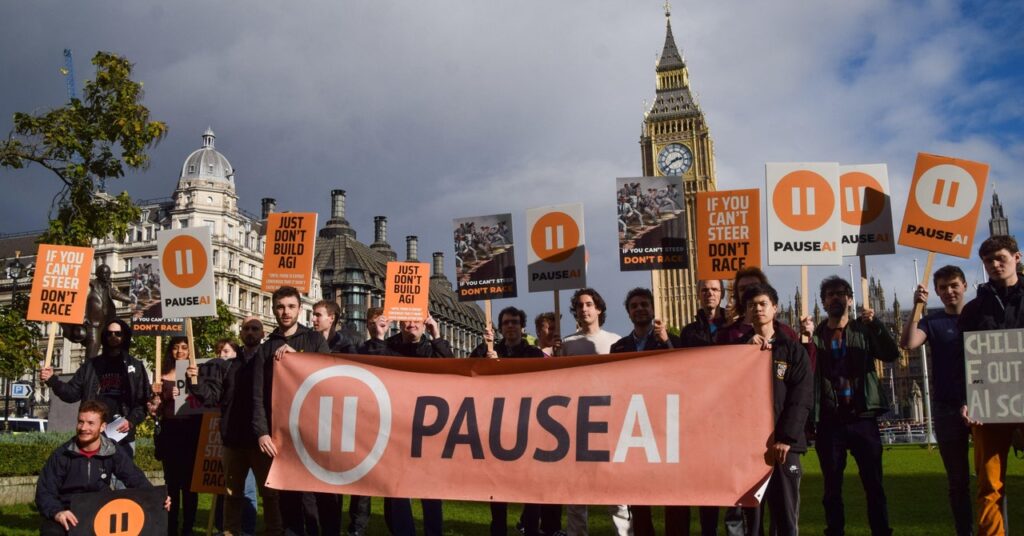Would it be too disruptive if protests staged sit-ins or chained themselves to the doors of AI developers, one member of the Discord asked. “Probably not. We do what we have to, in the end, for a future with humanity, while we still can.”
Meindertsma had been worried about the consequences of AI after reading Superintelligence, a 2014 book by philosopher Nick Bostrom that popularized the idea that very advanced AI systems could pose a risk to human existence altogether. Joseph Miller, the organizer of PauseAI’s protest in London was similarly inspired.
It was the launch of OpenAI’s large language model Chat-GPT 3 in 2020 that really got Miller worried about the trajectory AI was on. “I suddenly realized that this is not a problem for the distant future, this is something where AI is really getting good now,” he says. Miller joined an AI safety research nonprofit and later became involved with PauseAI.
Bostrom’s ideas have been influential in the “effective altruism” community, a broad social movement that includes adherents of long-termism: the idea that influencing the long-term future should be a moral priority of humans today. Although many of PauseAI’s organizers have roots in the effective altruism movement, they’re keen to reach beyond philosophy and garner more support for their cause.
Director of Pause AI US, Holly Elmore, wants the movement to be a “broad church” that includes artists, writers, and copyright owners whose livelihoods are put at risk from AI systems that can mimic creative works. “I’m a utilitarian. I’m thinking about the consequences ultimately, but the injustice that really drives me to do this kind of activism is the lack of consent” from companies producing AI models, she says.
“We don’t have to choose which AI harm is the most important when we’re talking about pausing as a solution. Pause is the only solution that addresses all of them.”
Miller echoed this point. He says he’s spoken to artists whose livelihoods have been impacted by the growth of AI art generators. “These are problems that are real today, and are signs of much more dangerous things to come.”
One of the London protesters, Gideon Futerman, has a stack of leaflets he’s attempting to hand out to civil servants leaving the building opposite. He has been protesting with the group since last year. “The idea of a pause being possible has really taken root since then,” he says.
Futerman is optimistic that protest movements can influence the trajectory of new technologies. He points out that pushback against genetically modified organisms was instrumental in turning Europe off of the technology in the 1990s. The same is true of nuclear power. It’s not that these movements necessarily had the right ideas, he says, but they prove that popular protests can stymie the march even of technologies that promise low-carbon power or more bountiful crops.
In London, the group of protesters moves across the street in order to proffer leaflets to a stream of civil servants leaving the government offices. Most look steadfastly uninterested, but some take a sheet. Earlier that day Rishi Sunak, the British prime minister who six months earlier had hosted the first AI Safety Summit, had made a speech where he nodded to fears of AI. But after that passing reference, he focused firmly on the potential benefits.
The Pause AI leaders WIRED spoke with said they were not considering more disruptive direct action such as sit-ins or encampments near AI offices for now. “Our tactics and our methods are actually very moderate,” says Elmore. “I want to be the moderate base for a lot of organizations in this space. I’m sure we would never condone violence. I also want Pause AI to go further than that and just be very trustworthy.”
Meindertsma agrees, saying that more disruptive action isn’t justified at the moment. “I truly hope that we don’t need to take other actions. I don’t expect that we’ll need to. I don’t feel like I’m the type of person to lead a movement that isn’t completely legal.”
The Pause AI founder is also hopeful that his movement can shed the “AI doomer” label. “A doomer is someone who gives up on humanity,” he says. “I’m an optimistic person; I believe we can do something about this.”
